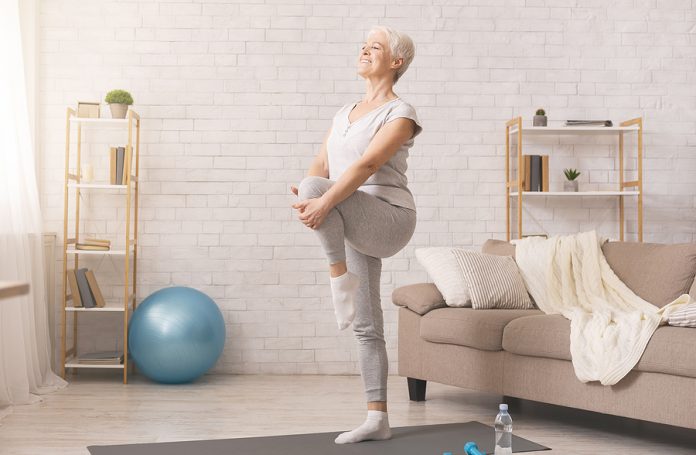Facts on senior exercise
George Burns (who lived to be 100) used to say, “If I knew I was going to live this long, I would have taken better care of myself!” It’s true that some individuals are blessed with good genes, and no matter how many unhealthy lifestyle habits they have, they’re going to live into old age. But for the rest of us who might be concerned with the quality of life as we age, exercise is one of the keys. Is it ever too late to start? Research proves it’s not. In this article, I’ll discuss the benefits of exercising into old age and then give you some tips on how to get started no matter how old you are.
The aging population
According to the American College of Sports Medicine, by the year 2030, the number of individuals in the United States 65 years and over will reach 70 million, and people 85 years and older will be the fastest-growing segment of the population. Some of you may already be there, while others may be approaching. But whatever your age, exercise can be beneficial. Below is a description of what happens to our bodies as we age and how exercise can make all the difference.
What happens to muscles as we age?
As many of us have already noticed, muscle mass decreases as we age. Beginning in the fourth decade of life, adults lose 3%-5% of muscle mass per decade, and the decline increases to 1%-2% per year after age 50. Muscle keeps us strong, it burns calories and helps us maintain our weight, and it is also an essential contributor to our balance and bone strength. Without it, we can lose our independence and our mobility.
Is it ever too late to build muscle?
The good news is that muscle mass can increase at any age in response to exercise. In an important study of weight lifting and older adults conducted with 100 male and female residents of a nursing home in Boston (age range: 72 to 98 years of age; average age 87), subjects lifted weights with their legs three times a week for 10 weeks.
At the end of the study, there was an increase in thigh mass of 2.7%, walking speed increased by 12%, and leg strength increased a whopping 113%!
In a similar study of adults 65-79 years old, subjects who lifted weights three times a week for three months increased their walking endurance by 38% (from 25 minutes to 34 minutes) without appreciable increases in mass. Ida Weiss, a 91-year-old participant in the Boston study, had the following to say after the study, “It’s very beneficial for me. Things that I couldn’t do when I came here, I can do now. I didn’t think that I was going to live anymore, but I feel different now.”
Exercise can be invigorating and help build muscle mass at any age.
Can I get stronger without building big muscles?
Importantly, strength isn’t just a function of mass. It’s also a function of something called “neurological patterning.” In layman’s terms, patterning is when the brain sends electrical signals via the nervous system to muscles to make them contract. For example, when you think about walking down the street, bending over to pick something up, or any other movement for that matter, the brain first processes the thought and figures out what muscles are needed to make the move and then sends the signal over the nerves to the particular muscles that are necessary for the movement. The muscles move (and so do you) once the signal reaches them. (See “How muscles work” for more detail.)
The good news here is that muscle patterning improves within days of starting a weight-lifting program, even without any increase in muscle mass. This explains the 113% increase in strength experienced by the residents of the nursing home in Boston in the previously cited study. In a different study that specifically investigated this phenomenon, 67- to 81-year-old men lifted weights for six weeks while hooked up to electrodes that measured their nerve and muscle patterning (an electromyogram machine).
What happens to endurance as we age?
Endurance decreases as we age. In one extensive study of more than 3,000 70-79-year-old men and women, researchers investigated the relationship between the speed at which these subjects walked ¼ of a mile and their risk of premature mortality, cardiovascular disease, and mobility limitation. The results showed that those with the slowest walk times (>6 minutes) had a higher risk of death, cardiovascular disease, and mobility limitation than those who walked the distance in less than four and a half minutes. In fact, every additional minute of walking time was associated with higher and higher degrees of risk; approximately 13% of the participants could not even complete the distance due to fatigue or symptoms such as breathlessness, cramping, etc.
There’s good news that should serve as an encouragement to all of us when it comes to fitness, walking endurance, and health. In a classic study of walking and mortality in 700 men enrolled in the Honolulu Heart Program, the mortality rate among the men who walked less than one mile per day was near twice the rate of those who walked more than two miles per day. (Studies of women showed similar results). In another study, data collected on more than 41,000 men and women from 1990 to 2001 were analyzed to find the relationship between walking and mortality.
It was reported that men and women who walked 30 minutes or more per day during the study period had fewer deaths than those who walked less than 30 minutes.
Interestingly, even men and women who smoked or were overweight were protected from early death if they walked more than 30 minutes per day.
Facts on senior exercise
Exercise starts now
Exercise is an important key to aging successfully. It’s never too late to start.
George Burns (who lived to be 100) used to say, “If I knew I was going to live this long, I would have taken better care of myself!” It’s true that some individuals are blessed with good genes, and no matter how many unhealthy lifestyle habits they have, they’re going to live into old age. But for the rest of us who might be concerned with the quality of life as we age, exercise is one of the keys. Is it ever too late to start? Research proves it’s not. In this article, I’ll discuss the benefits of exercising into old age and then give you some tips on how to get started no matter how old you are.
The aging population
According to the American College of Sports Medicine, by the year 2030, the number of individuals in the United States 65 years and over will reach 70 million, and people 85 years and older will be the fastest-growing segment of the population. Some of you may already be there, while others may be approaching. But whatever your age, exercise can be beneficial. Below is a description of what happens to our bodies as we age and how exercise can make all the difference.
What Happens to Muscles As We Age?
As many of us have already noticed, muscle mass decreases as we age. Beginning in the fourth decade of life, adults lose 3%-5% of muscle mass per decade, and the decline increases to 1%-2% per year after age 50. Muscle keeps us strong, it burns calories and helps us maintain our weight, and it is also an essential contributor to our balance and bone strength. Without it, we can lose our independence and our mobility.
Is it ever too late to build muscle?
It’s never too late to exercise and build muscle.
It’s never too late to exercise and build muscle. The body is responsive to strength training at any age.
The good news is that muscle mass can increase at any age in response to exercise. In an important study of weight lifting and older adults conducted with 100 male and female residents of a nursing home in Boston (age range: 72 to 98 years of age; average age 87), subjects lifted weights with their legs three times a week for 10 weeks.
At the end of the study, there was an increase in thigh mass of 2.7%, walking speed increased by 12%, and leg strength increased a whopping 113%!
In a similar study of adults 65-79 years old, subjects who lifted weights three times a week for three months increased their walking endurance by 38% (from 25 minutes to 34 minutes) without appreciable increases in mass. Ida Weiss, a 91-year-old participant in the Boston study, had the following to say after the study, “It’s very beneficial for me. Things that I couldn’t do when I came here, I can do now. I didn’t think that I was going to live anymore, but I feel different now.”
Exercise can be invigorating and help build muscle mass at any age.
Can I get stronger without building big muscles?
Importantly, strength isn’t just a function of mass. It’s also a function of something called “neurological patterning.” In layman’s terms, patterning is when the brain sends electrical signals via the nervous system to muscles to make them contract. For example, when you think about walking down the street, bending over to pick something up, or any other movement for that matter, the brain first processes the thought and figures out what muscles are needed to make the move and then sends the signal over the nerves to the particular muscles that are necessary for the movement. The muscles move (and so do you) once the signal reaches them. (See “How muscles work” for more detail.)
The good news here is that muscle patterning improves within days of starting a weight-lifting program, even without any increase in muscle mass. This explains the 113% increase in strength experienced by the residents of the nursing home in Boston in the previously cited study. In a different study that specifically investigated this phenomenon, 67- to 81-year-old men lifted weights for six weeks while hooked up to electrodes that measured their nerve and muscle patterning (an electromyogram machine).
The results showed that the men experienced a 25% increase in the patterning of the muscle along with a 35% increase in strength, all without significant increases in size.
Health News
How Is Autism Diagnosed?
Simple Eye Test Might Spot Autism in Kids
Stressed Parents Could Mean More Self-Harm by Kids
CDC Experts Recommend Seniors Get Another COVID Shot
Impaired Sense of Direction Could Be Early Alzheimer’s Sign
What happens to endurance as we age?
Endurance decreases as we age. In one extensive study of more than 3,000 70-79-year-old men and women, researchers investigated the relationship between the speed at which these subjects walked ¼ of a mile and their risk of premature mortality, cardiovascular disease, and mobility limitation. The results showed that those with the slowest walk times (>6 minutes) had a higher risk of death, cardiovascular disease, and mobility limitation than those who walked the distance in less than four and a half minutes. In fact, every additional minute of walking time was associated with higher and higher degrees of risk; approximately 13% of the participants could not even complete the distance due to fatigue or symptoms such as breathlessness, cramping, etc.
There’s good news that should serve as an encouragement to all of us when it comes to fitness, walking endurance, and health. In a classic study of walking and mortality in 700 men enrolled in the Honolulu Heart Program, the mortality rate among the men who walked less than one mile per day was near twice the rate of those who walked more than two miles per day. (Studies of women showed similar results). In another study, data collected on more than 41,000 men and women from 1990 to 2001 were analyzed to find the relationship between walking and mortality.
It was reported that men and women who walked 30 minutes or more per day during the study period had fewer deaths than those who walked less than 30 minutes.
Interestingly, even men and women who smoked or were overweight were protected from early death if they walked more than 30 minutes per day.
What happens to flexibility as we age?
You guessed it. It decreases. The good news is that some studies, but not all, show improvements in flexibility when individuals engage in exercise programs that involve stretching exercises. Unfortunately, the studies on flexibility in the aging population aren’t as complete as they are for studies of strength and endurance, but the studies do suggest that significant improvements in the range of motion of various joints (neck, shoulder, elbow, wrist, hip, knee, and ankle) can occur when stretching exercises are prescribed. It’s just that it isn’t clear how much flexibility training older adults should do to maintain a good range of motion and joint function.
What happens to balance as we age?
Balance decreases as we age, and consequently, falling is a major concern for the elderly. According to the U.S. Centers for Disease Control and Prevention (CDC), one of every three Americans over the age of 65 falls each year, and among individuals 65-84, falls account for 87% of all fractures and are the second leading cause of spinal cord and brain injury. The good news is that physical activity can improve balance and reduce the risk of falling. The results of a study of 256 older adults (70 to 92 years of age, average age 77) who participated in tai chi for six months found that there were 52% fewer falls in the individuals who did tai chi compared to those who didn’t.
Combining the results of many studies on the same subject, it was reported that muscle strengthening and balance retraining exercises in 1,016 older men and women (ages 65 to 97) reduced the risk of falls and fall injuries by as much as 35%-45%.
One of the important conclusions of the research is that it’s important to select balance-training exercises that are specific to activities you are likely to do during the day. For instance, you might want to do balance exercises on one leg that mimic the act of walking if you are unsteady while you walk (when you walk, one leg is in the air). Tai chi is excellent for this because it involves slow, coordinated movements, and is particularly beneficial for balance since you lift one leg frequently while doing it.
What happens to bones as we age?
Bones tend to decrease in density as we age, and for some individuals, it can lead to osteoporosis. Osteoporosis is a disease of low bone density that can contribute to an increased risk of fracture. According to the National Osteoporosis Foundation, osteoporosis and low bone mass affect 54 million Americans.
Osteoporosis is responsible for 2 million fractures annually. The good news is that exercise can increase bone density in some older individuals. The precise amount and type of exercise necessary to achieve benefit are unknown, but encouragingly, research shows that weight lifting, and even just walking, can increase bone density in the hip and spine. The reason for this may be that weight lifting causes stress on the bones as the muscles contract (which causes the bones to thicken), and walking also causes stress on the bones, which stimulates them to grow.
In two different studies—one of the men 50-70 years of age who lifted weights three times a week for 16 weeks, and the other of women 40-70 years of age who lifted twice a week for one year, bone density in the leg and back was shown to increase. There is also some evidence that walking can increase bone density in the hips and lower back, but the recommendation for frequency and intensity of the walking is not clear. What is clear is that exercise does help build or preserve bone density, and so it is recommended that we stay active for the sake of our bones and overall health.
What happens to our joints as we age?
Many aging adults are susceptible to osteoarthritis (the type of arthritis that affects bones by wearing down the cushion that pads the space between them).
In a large study of 439 adults (aged 60 and older) with osteoarthritis who did either aerobic exercise (walking) or resistance exercise (weight lifting) for 18 months,
participants in the aerobic exercise group had a 10% decrease in a physical disability questionnaire,
a 12% lower score on a knee pain questionnaire, and
outperformed non-exercising individuals in the study on the following tests: a six-minute walk test (they walked further); the time it took them to climb and descend stairs; the time it took them to lift and carry 10 pounds, and the time it took them to get in and out of a car.
In the weight-lifting, group, there was an 8% lower score on the physical disability questionnaire,
8% lower pain score,
greater distance on the six-minute walk, and
faster times on the lifting and carrying task and the car task than in the individuals in the study who did not exercise.
Other studies confirm that exercise can improve function for people with arthritis. Make sure to check out the Arthritis Foundation Web site for more information on exercise and in particular, their PACE program (People with Arthritis Can Exercise). They offer exercise videos and water classes all over the country.
Does exercise help cognitive function?
One of the most exciting areas of exercise research is the investigation of cognitive function. What scientists have learned so far is that brain neuron, the special cells that help you think, move, perform all the bodily functions that keep you alive, and even help your memory, all increase in number after just a few days or weeks of regular activity. In a study in which researchers used an MRI machine to measure the amount of brain tissue in adults 55 years of age and older, they found results, consistent with other studies of aging and brain volume, showing there were substantial declines in brain tissue density as a function of age in areas of the brain responsible for thinking and memory, but importantly, the losses in these areas were substantially reduced as a function of cardiovascular fitness. In other words, the fittest individuals had the most brain tissue.
How might fitness and more brain tissue help you? Researchers have found that the fittest elders had the highest scores on tasks like coordination, scheduling, planning, and memory. And in a recent study of 1,740 adults older than 65, researchers found that the incidence of dementia in individuals who walked three or more times per week was 35% lower than those individuals who walked less than three days per week.
Can exercise improve mood?
Research suggests that as many as 14% of males and 18% of females over age 55 are depressed. It has been documented, in younger adults, that exercise can alleviate symptoms of depression and even compete with the effects of antidepressant medication or psychotherapy in terms of effectiveness. Unfortunately, there is very little research on the effects of exercise on depression in older adults. What is fair to say is that exercise has a mood-elevating effect in most adults, whatever their age, even if it’s not the cure for depression in the elderly. Talk to almost anyone who exercises, no matter what their age and they will report what used to be called a “feel-good” phenomenon after exercise. Whether it’s from getting the heart beating or the blood pumping, from invigorating brain cells, or simply getting out in the fresh air, a good dose of exercise typically improves mood, and so is recommended for virtually everyone.
How much exercise do I need to do for health and fitness?
The American College of Sports Medicine and the American Heart Association recently published guidelines for physical activity in older adults. Here is a summary of the recommendations.
Aerobic exercise (walking, jogging, dancing, biking, swimming, etc.): To promote and maintain health, older adults need moderate-intensity aerobic physical activity for a minimum of 30 minutes five days each week or vigorous-intensity aerobic activity for a minimum of 20 minutes three days each week. (Moderate intensity is when you feel “warm and slightly out of breath,” and vigorous is when you feel “out of breath and sweaty.”)
Resistance exercise (weight lifting, calisthenics): To promote and maintain health and physical independence, older adults will benefit from performing activities that maintain or increase muscular strength and endurance for a minimum of two days each week. It is recommended that eight to 10 exercises be performed on two or more nonconsecutive days per week using the major muscle groups.
Flexibility exercise: To maintain the flexibility necessary for regular physical activity and daily life, older adults should perform activities that maintain or increase flexibility at least two days each week for at least 10 minutes each day.
Balance exercise: To reduce the risk of injury from falls, older adults with a substantial risk of falls (those with frequent falls or mobility problems) should perform exercises that maintain or improve balance.
How do I get started?
There’s no need to try and make up for years of inactivity overnight. In fact, you could get injured or quickly become burned out by doing that. Instead, start slowly and build up gradually. If that means starting with just five minutes of walking, then that’s what you ought to do. In fact, one of my favorite plans to recommend for getting started is the five-minute-out, five-minute-back plan. Just like it sounds, you walk out for five minutes, turn around, and walk back. That’s it…10 minutes of walking, and off you go about your day. If you feel ambitious, you can do seven and a half or even 10 minutes out and back, and add some stretching when you finish if you like. One of the best ways to get motivated and stay that way is to set goals. I suggest that you set a weekly exercise plan, starting today for the week coming up. Write down what day(s) of the week, what time of day, the minutes of activity, and the activity that you’ll do. Be as specific and realistic as possible, and remember that it’s not how much you do when you get started but that you simply get started. Keep setting and reviewing your goals weekly for at least three months. That way you’ll be sure to stay on track and build exercise into your life as a habit.
What are some senior exercise programs at home?
For aerobic exercise: Walking, dancing (when’s the last time you took a ballroom-dancing class?), biking, and swimming are all good options. You can also try exercise videos. Collage Video is a good resource. They have lots of videos for individuals of all ages (search their site for “seniors”). Also check out your local senior center, rec center, Y, or local fitness center for classes that are appropriate for you. Many centers offer exercise classes for seniors. They’re out there if you look.
For resistance exercise: You don’t need to pump iron in a gym to do resistance exercise. Of course, if you want to go to the gym, I wouldn’t discourage you. But if you prefer to do it at home, you can. I recommend exercise tubing if you’re looking for a simple but effective way to do resistance exercise at home. Exercise tubing is inexpensive and versatile (you can do lots of very different exercises with them) and they are a great way to get started with resistance exercise. You can start with a set of four for about $20. They come in colors to denote the tension. If you order them, make sure to order the strap that allows you to attach the tube to a door, and if you want to work your legs, ask for leg straps. Here are some vendors that sell them:
If you don’t get around very well and prefer to exercise sitting down, try exercise videos in a chair. Collage Video and Armchair Fitness are two good resources.
For flexibility exercise: There are lots of good resources for stretching exercises.
Search by keyword “stretch” or “flexibility” at Collage Video, and you’ll come up with a multitude of possibilities.
I recommend yoga if you want to learn how to stretch. Check for yoga centers in your neighborhood or at your local rec center or senior center.
Check your local rec center or Y for stretching classes. Stretching classes are a great way to relax, improve your flexibility, and maybe even meet some new people!

























